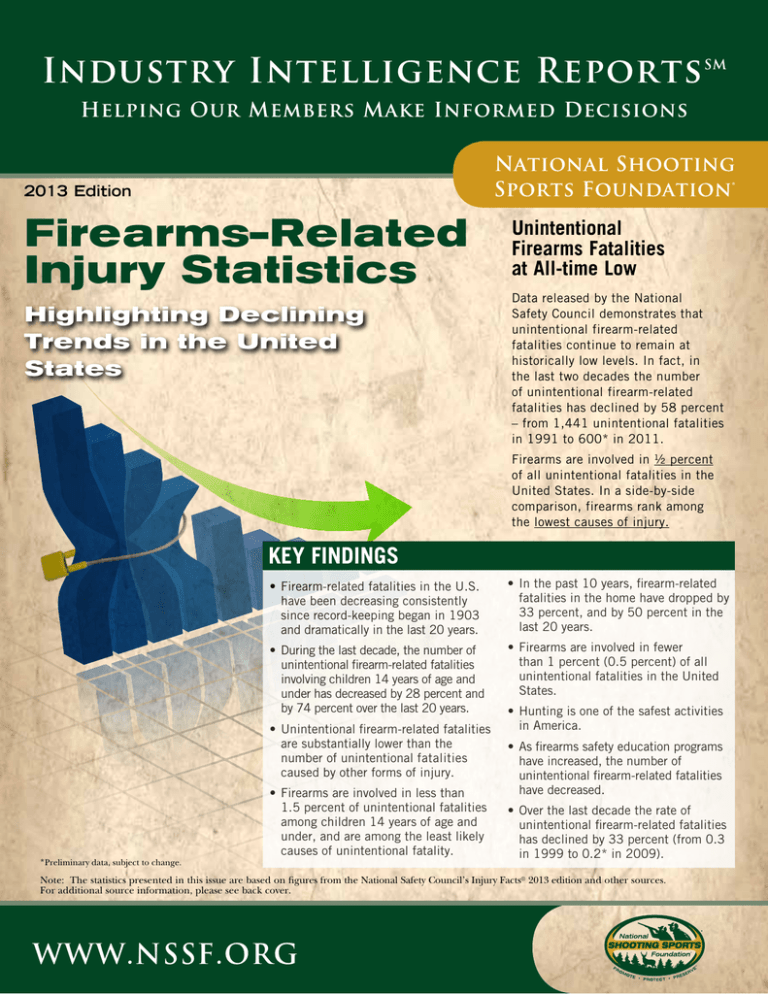
Industry Intelligence Reports
SM
Helping Our Members Make Informed Decisions
National Shooting
Sports Foundation®
2013 Edition
Firearms-Related
Injury Statistics
Highlighting Declining
Trends in the United
States
Unintentional
Firearms Fatalities
at All-time Low
Data released by the National
Safety Council demonstrates that
unintentional firearm-related
fatalities continue to remain at
historically low levels. In fact, in
the last two decades the number
of unintentional firearm-related
fatalities has declined by 58 percent
– from 1,441 unintentional fatalities
in 1991 to 600* in 2011.
Firearms are involved in ½ percent
of all unintentional fatalities in the
United States. In a side-by-side
comparison, firearms rank among
the lowest causes of injury.
KEY FINDINGS
•Firearm-related fatalities in the U.S.
have been decreasing consistently
since record-keeping began in 1903
and dramatically in the last 20 years.
•In the past 10 years, firearm-related
fatalities in the home have dropped by
33 percent, and by 50 percent in the
last 20 years.
•During the last decade, the number of
unintentional firearm-related fatalities
involving children 14 years of age and
under has decreased by 28 percent and
by 74 percent over the last 20 years.
•Firearms are involved in fewer
than 1 percent (0.5 percent) of all
unintentional fatalities in the United
States.
•Unintentional firearm-related fatalities
are substantially lower than the
number of unintentional fatalities
caused by other forms of injury.
*Preliminary data, subject to change.
•Firearms are involved in less than
1.5 percent of unintentional fatalities
among children 14 years of age and
under, and are among the least likely
causes of unintentional fatality.
•Hunting is one of the safest activities
in America.
•As firearms safety education programs
have increased, the number of
unintentional firearm-related fatalities
have decreased.
•Over the last decade the rate of
unintentional firearm-related fatalities
has declined by 33 percent (from 0.3
in 1999 to 0.2* in 2009).
Note: The statistics presented in this issue are based on figures from the National Safety Council’s Injury Facts® 2013 edition and other sources.
For additional source information, please see back cover.
www.nssf.org
Page 1
Industry Intelligence Reports
2013 Edition
Unintentional Firearms Fatalities Down 58%
58
%
This decline is attributed to a number of factors,
including educational efforts by groups such as the
National Shooting Sports Foundation and National Rifle
Association, and state-affiliated hunter education programs.
Industry-related initiatives include education programs
such as NSSF’s Project ChildSafe®, free firearm locking
devices voluntarily supplied by firearms manufacturers
with new firearms, and technological advances in firearm
designs and manufacturing processes.
Down
Down
600*
300
0
* Preliminary
Source: National Safety Council Injury Facts 2013 Editon
2001
2011 *
% change % change
(10 yrs)
(20 yrs)
Firearms
1,441
802
600
down 25% down 58%
Fires, Flames, Smoke
4,120
3,309
2,800
down 15% down 32%
Motor Vehicles
43,536
43,788
34,600
down 21% down 21%
Choking
3,240
4,185
4,600
up 10%
up 42%
All Types**
89,347
101,537
122,900
up 21%
up 38%
v The rate of unintentional firearm fatalities
is substantially lower than the rate of motor
vehicle fatalities.
v A person is 56 times more likely to be involved
in an unintentional fatality with a motor vehicle
than with a firearm.
15.4 15.8 15.4 15.3 15.3
15.2
14.6
13.1
11.8
11.4
11.1
10
5
0
0.3
0.3
0.3
0.2
0.3
0.2
0.2
0.2
0.2
0.2
0.2*
1
2011
v Over the past 10 years, the unintentional
firearm fatality rate per 100,000 population has
declined by 33 percent; since the beginning of
record-keeping in 1903, this rate has declined
by 94 percent!
15
fatalities Per 100,000 Population
0
2010
v Unintentional fatality rates involving firearms
remain at their lowest levels in history —
0.2 per 100,000 population.
20
9
2009
Unintentional Fatality Rates:
Firearms vs Motor Vehicles
National Safety Council Injury Facts 2013 Edition
8
2008
*Preliminary data, subject to change.
**Note: Total includes types of injury not listed in the grid above. Other
injury-type comparisons are not available due to changes in year-to-year
classifications.
1991
7
2007
Compared to other principle types of
unintentional fatalities in the United States,
firearms continue to show the largest
percentage decrease in the past two decades.
Type
2001
1
Unintentional Firearm
Fatalities See Highest
Rate of Decline
6
2006
600
5
2005
802
4
2004
1,200
900
Over the last two decades, the number of unintentional
fatalities involving firearms (excluding homicide and
suicide) has dropped by 58 percent.
20 Years:
Down
3
2003
1,441
2
2002
1,500
ry)
* Preliminary
National Safety Council Injury Facts 2013 Edition (with 2011 data)
Page 2
Drowning
18%
Suffocation
Industry Intelligence
Reports
2013 Edition
27%
Fires 7%
Poisoning 2%
Falls 1%
Environmen
Firearms 1
Motor
Firearms are Involved
in Vehicle
Less Than 1.5 Percent
Other 6%
34% Among Children
of Unintentional Fatalities
FACTS & Figures
Firearms are Involved in 0.5 Percent
of All Unintentional Fatalities
(For All Ages)
Total U.S. Population (2010): 308,745,538
Total Unintentional Fatalities
120,859 100%
Motor Vehicle
33,687 27.9%
Poisoning
33,041 27.3%
Falls
26,009 21.5%
Suffocation
6,165
5.1%
Drowning
3,782
3.1%
Fires, Flames & Smoke
2,845
2.4%
Natural / Environmental
1,576
1.3%
Transportation (other than land)
875
0.7%
Struck By / Against Object
788
0.7%
Firearms
606
0.5%
Machinery
590
0.5%
10,895
9.0%
All Other Accidents
Motor Vehicle
34%
0
2,000
97
62
94
P
S
D
Fire Envi
F
1,418
ron oisoni alls
or V uffoca row1,118
s
ng
me
ehi
tion ning
n
c
tal
le
1,000
726
308
97
Mot
S
D
F
or V uffoca rowni ires
ng
ehi
t
cle ion
Env
62
iro
ent
son Falls
ing
al
T
200
AL
OT
Down
1,871
1,441
1,000
15
802
Down
100
600*
500
0
262
Fire
O
arm ther
s
Over the last two decades the number of
unintentional firearm-related fatalities among
youth 14 years of age and under decreased by
74 percent, and by 28 percent in the last 10 years.
2,360
1,500
O
arm ther
s
Firearm-related Fatalities Among
Youth Down 74 Percent
250
2,247 2,204
Fire
62
Poi
nm
50
1930 1931 1941 1951 1961 1971 1981 1991 2001 2011
0
* Preliminary
Souce: National Safety Council Injury Facts 2013 Edition
1990
2000
2010
Source: CDC WISQARS Injury Mortality Reports (2010 data)
Page 3
262
62
Mot
94
Source: CDC WISQARS
0 2012 Edition (2010 figures)
3,100
2,396
Poisoning 2%
Falls 1%
Environmental 2%
Firearms 1%
Other 6%
726
308
3,000
2,000
Fires 7%
1,118
1,000
Today, the annual number of unintentional
firearm-related fatalities is down 81.3 percent
from a high of 3,200 in 1929 and in 1930.
2,500
Suffocation
27%
Drowning
18%
1,418
Historical Flashback
3,200
(14 years of age and under)
2,000
Source: CDC WISQARS Injury Mortality Reports (2010 data)
3,500
Unintentional Fatalities:
For children and youth
14 years of age and
under, unintentional
injuries are the leading
cause of fatality.
But firearms account
for the lowest cause of
injury among youth.
Industry Intelligence Reports
State Level
2011: Types of Unintentional Fatalities in the Home*
†
(2010)
State
# of Unintentional
Firearm-related
Fatalities**
Population
Crude
Rate**
0.73
AL
35
4,779,736
AK
*
710,231
AZ
12
6,392,017
0.19
AR
14
2,915,918
0.48
CA
24
37,253,956
0.06
CO
*
5,029,196
CT
*
3,574,097
DE
*
897,934
DC
*
601,723
FL
15
18,801,310
0.08
GA
42
9,687,653
0.43
HI
*
1,360,301
ID
*
1,567,582
IL
22
12,830,632
0.17
IN
18
6,483,802
0.28
IA
*
3,046,355
KS
12
2,853,118
0.42
KY
16
4,339,367
0.37
0.95
LA
43
4,533,372
ME
*
1,328,361
MD
*
5,773,552
MA
*
6,547,629
MI
16
9,883,640
MN
*
5,303,925
MS
*
2,967,297
MO
13
5,988,927
MT
*
989,415
NE
*
1,826,341
NV
*
2,700,551
NH
*
1,316,470
NJ
*
8,791,894
0.07
NC
30
9,535,483
0.31
OK
24
3,751,351
OR
*
3,831,074
PA
32
12,702,379
RI
*
1,052,567
SC
20
4,625,364
SD
*
814,180
TN
32
6,346,105
0.5
TX
54
25,145,561
0.21
UT
*
2,763,885
VT
*
625,741
VA
13
8,001,024
WA
*
6,724,540
WV
10
1,852,994
WI
*
5,686,986
WY
*
563,626
TOTAL
606
308,745,538
600
400*
Down
25%
400
2,059,179
672,591
800
Over the last two decades the number of unintentional
firearm-related fatalities in the home decreased
by 50%; by 33% in the last 10 years.
600
19,378,102
11,536,504
Firearm-related Home Fatalities Down 50%*
0.22
*
*
Source: Home Data: Injury Facts Report from the National Safety Council
Injury Facts 2013 Edition [Home, 2011] section
* preliminary data
800
13
*
Total Home
60,600
%
Poisoning
30,200 49.8%
Falls
17,500 28.9%
Fire, Flames, Smoke
2,500 4.1%
Choking
2,300 3.8%
Mechanical Suffocation 1,400 2.3%
Drowning
1,000 1.7%
Natural Heat/Cold
500
0.8%
Firearms
400
0.7%
Other
4,800
8%
0.16
NY
ND
Less than 0.7% of fatal accidents
at home involve firearms
1000
NM
OH
2013 Edition
0.64
0.25
0.43
0.16
0.54
0.20
Source: U.S. Dept. of Health and Human Services, Center
for Disease Control and Prevention, National Center for
Injury Prevention and Control (NCICP), WISQARS
(Web based Injury Statistics Query and Reporting System)
** CDC WISQARS Fatal Injury Data (2008 forward) is
suppressed where totals are under 10. The figures
reported for these states are not available. The National
TOTAL reported is the national total and will not equal
the numbers supplied in the table. ** Per NCICP, rates based on 20 or fewer fatalities may be
unstable. Use with caution.
Down
33%
200
0
1991
2001
2011*
National Safety Council Injury Facts 2013 Edition (Home, 2011 section) (*preliminary data)
Regional Trends
In the past
10-year
20-year
Region
1990 2000 2010
two decades, all
% change % change
four regions of the
88
57
-35.2%
-49.6%
United States have Northeast 113
experienced
South
765 391 361
-7.7%
-52.8%
dramatic declines
Midwest
258 162 107
-34.0%
-58.5%
in the number
of unintentional
West
280 135
81
-40.0%
-71.1%
firearm-related
fatalities. This is
Total
1,416 776 606
-21.9%
-57.2%
a clear indication Source: CDC WISQARS (Web-based Injury Statistics Query and Reporting System)
Injury Mortality Reports (2010 data) that firearms
manufacturers’ safety efforts and regional and state educational programs
are working successfully.
Page 4
Industry Intelligence Reports
2013 Edition
Participation and Injury Data 2011
ACTIVITY
(alphabetically)
Archery (target)
NUMBER OF
PARTICIPANTS(a)
2011
TOTAL
INJURIES(b)
2011
INJURIES
per 100,000
PARTICIPANTS
ONE (1) INJURY
FOR EVERY x
PARTICIPANTS
6,300,000
4,933
78
1,277
Baseball
12,300,000
155,100
1,261
79
Basketball
26,100,000
536,840
2,057
49
Bicycle Riding
39,100,000
540,339
1,382
72
Billiards / Pool
20,000,000
3,266
16
6,124
Bowling
34,900,000
19,281
55
1,810
Camping (vacation/
overnight)
42,800,000
5,257
12
8,142
3,100,000
38,108
1,229
81
Exercise activity
55,500,000
255,494
460
Fishing
37,700,000
66,893
9,000,000
SAFEST ACTIVITIES
PERCENTAGE OF
INJURY PER 100
PARTICIPANTS
1
Camping (vacation/overnight)
0.01%
2
Billiards / Pool
0.02%
3
Hunting with Firearms
0.04%
4
Bowling
0.06%
5
Running / Jogging
0.07%
6
Archery (target)
0.08%
7
Tennis
0.14%
8
Mountain Biking (off road)
0.15%
217
9
Water Skiing
0.15%
177
564
10
Golf
0.16%
467,731
5,197
19
20,900,000
32,677
156
640
Gymnamstics
5,100,000
26,371
517
193
Hockey (ice)
3,000,000
19,703
657
152
2,439
Cheerleading
Football (tackle)
Golf
16,400,000
6,759*
41
In-line rollerskating
Hunting with Firearms
6,100,000
67,274
1,103
91
Lacrosse
2,700,000
20,648
765
131
Mountain Biking (off
road)
6,000,000
8,859
148
677
1,383
38,700,000
27,992
72
Skateboarding
Running / Jogging
6,600,000
108,510
1,644
61
Snowboarding
5,100,000
42,537
834
120
Soccer
13,900,000
214,053
1,540
65
Softball
10,400,000
107,033
1,029
97
Swimming
46,000,000
205,662
447
224
Tennis
13,100,000
18,920
144
692
Volleyball
10,100,000
58,803
582
172
4,300,000
6,539
152
658
29,100,000
95,486
328
305
3,200,000
44,850
1,402
71
Water Skiing
Weight Lifting
Wrestling
FACT: Excise tax collections on items
such as firearms and ammunition totaled
more than $1.8 billion during 2008 – 2012.
Approximately $350 million of these monies
were apportioned to states for the purpose of
hunter education and safety training. This,
along with a strong network of nearly 70,000
dedicated hunter education instructors, help
make hunting one of the safest activities in
America. Sources: USFW & IHEA
Hunting versus other ACTIVITIES:
A person is 14 times more likely to be injured playing volleyball than hunting.
LESS SAFE ACTIVITIES
PERCENTAGE OF
INJURY PER 100
PARTICIPANTS
1
Football (tackle)
5.20%
2
Basketball
2.06%
3
Skateboarding
1.64%
4
Soccer
1.54%
5
Wrestling
1.40%
6
Bicycle Riding
1.38%
7
Baseball
1.26%
8
Cheerleading
1.23%
9
In-line rollerskating
1.10%
10
Softball
1.03%
A person is 30 times more likely to be injured in cheerleading or baseball than hunting.
A person is 34 times more likely to be injured bicycle riding or wrestling than hunting.
A person is 38 times more likely to be injured playing soccer than hunting.
A person is 50 times more likely to be injured playing basketball than hunting.
A person is 127 times more likely to be injured playing tackle football than hunting.
Sources:
(a) Number of Participants: National Sporting Goods Association (NSGA) Sports Participation 2011 estimates.
(b) Total Injuries: Consumer Products Safety Commission (CPSC) National Electronic Injury Surveillance System (NEISS) 2010 estimates. Per CPSC, NEISS injury data may contain
both injury and fatality figures for some activities. The majority of injuries are non-fatal, and specific breakouts of injury versus fatality data by activity are unavailable.
* Hunting with firearms total injuries/incidents include CPSC NEISS injury data for Tree Stands (hunting) as well as estimated injuries from IHEA Hunter Incident Clearinghouse.
Page 5
Industry Intelligence Reports
2013 Edition
Deer / Vehicle Collision:
What are your odds?
Map Legend (odds)
Region
New England
Middle Atlantic
East North Central
West North Central
South Atlantic
East South Central
West South Central
Mountain
Pacific
2012 Highest Number of Incidents per Region
VT odds 1 in 183
PA odds 1 in 76
MI odds 1 in 72
SD odds 1 in 68
WV odds 1 in 40
MS odds 1 in 120
AR odds 1 in 96
MT odds 1 in 79
OR odds 1 in 303
Sources: State Farm Mutual Automobile Insurance Company and Federal Highway Administration,
Department of Transportation (DOT)
For charts containing individual state data, as well as other information, visit http://www.statefarm.com.
FACTS:
Year
1993
1997
2000
2003
2007
Increase in Fatalities
1993 to 2007
Number of Deaths Caused by Collisions with
Animals* in the U.S.
101
136
150
212
223
121%
Source: Highway Loss Data Institute (News Release, October 30, 2008)
Source: Highway Loss Data Institute
* According to U.S. Dept of Transportation, Federal Hwy Administration, Wildlife-Vehicle Collision Reduction
Study, Report to Congress, Aug. 2008, deer account for 86.9% of the collisions with larger animals.
Page 6
• More than 19,500 human injuries occur
annually from deer-vehicle collisions.
• Deer-vehicle collisions are estimated
at greater than 1,000,000 each year.
• Deer-vehicle collisions cost Americans
an estimated $1.5 billion in auto repairs each year.
Sources: USDOT Federal Highway Administration
Wildlife-Vehicle Collision Reduction Study and Responsive
Management’s Public Attitudes Toward Wildlife Management Problems
Industry Intelligence Reports
2013 Edition
Help prevent deer/vehicle collisions
by practicing the following:
• Stay alert when driving and watch for deer – particularly in
areas where deer crossing signs are posted.
• Be extra cautious at dawn and dusk when the deer are most
active.
• Drive with extreme caution during the months of October and
November. Deer increase their travels during these breeding
months which is when most accidents with deer occur.
• Remember that deer quite often travel in small groups.
If you see one, expect more.
• Use high beams whenever appropriate.
• Don’t count on deer whistles to be an adequate deterrent.
• Avoid making any extreme maneuver with your car. If
you cannot avoid the collision, apply brakes until the last
second, and then remove your foot from the brake pedal.
This action will reduce the possibility of the deer colliding
with the windshield.
State agencies also contribute to reducing the number of potential deer/vehicle encounters
by exercising sound deer management practices and adjusting harvest limits.
ODDS OF DEER/VEHICLE Incidents BY REGION
2011
Licensed Drivers*
(by Region)
2012 Estimated
Number of Deer/Vehicle
Incidents** (by Region)
2012 Estimated Odds
of Deer/Vehicle Incidents
(by Region)
14,250,253
149,917
1 in 95
34,132,762
303,707
1 in 112
NJ, NY, PA
25,985,015
227,025
1 in 114
AL, KY, MS, TN
DE, D.C., FL, GA, MD,
NC, SC, VA, WV
AR, LA, OK, TX
13,228,795
88,802
1 in 149
41,999,809
253,990
1 in 165
22,635,479
87,937
1 in 257
CT, ME, MA, NH, RI, VT
AZ, CO, ID, MT, NV,
NM, UT, WY
AK, CA, HI, OR, WA
11,012,677
32,027
1 in 344
15,387,574
41,780
1 in 368
33,242,285
46,524
1 in 715
211,874,649
1,231,710
1 in 172
Region
Regional States
West North Central
East North Central
IA, KS, MN, MO, NE,
ND, SD
IL, IN, MI OH, WI
Middle Atlantic
East South Central
South Atlantic
West South Central
New England
Mountain
Pacific
TOTAL: UNITED STATES
Sources: * Federal Highway Administration, Department of Transportation (DOT) website. Nov 2012
** State estimates for deer/vehicle incidents from State Farm Mutual Automobile Insurance Company. Full state listing available at www.statefarm.com.
2012 Highest Incident States (Top 5)
2012 Estimated Odds of Deer/Vehicle Incidents
West Virginia
South Dakota
Michigan
Iowa
Pennsylvania
1
1
1
1
1
Page 7
in
in
in
in
in
40
68
72
73
76
About NSSF®
The National Shooting Sports Foundation is the trade association for the firearms industry. Its mission is to promote, protect
and preserve hunting and the shooting sports.
Formed in 1961, NSSF’s membership consists of manufacturers, distributors, firearms retailers, shooting ranges, sportsmen’s
organizations and publishers. For more information, log on to www.nssf.org
Sources
National Safety
Council (NSC)
Injury Facts© 2013
edition
CenterS for Disease
Control and
Prevention (CDC)
National Sporting
Goods Association
(NSGA)
International
Hunter Education
Association (IHEA)
Consumer
Products Safety
Commission (CPSC)
National Electronic
Injury Surveillance
System (NEISS)
State Farm Mutual
Automobile
Insurance Company
The National Safety Council, chartered by an act of Congress, is a non-government, not-for-profit,
public service organization with a mission to educate and influence people to prevent unintentional
injury and death. Injury Facts, the Council’s annual statistical report on unintentional injuries, is
prepared by the Research and Statistical Services Group.
www.nsc.org/Pages/Home.aspx
The CDC is one of the major operating components of the United States Department of Health and
Human Services. WISQARS is the CDC’s Web-based Injury Statistics Query and Reporting System.
Centers for Disease Control and Prevention, National Center for Injury Prevention and Control. Webbased Injury Statistics Query and Reporting System (WISQARS) [online]. (2005) [cited 2013 APR 02].
Available from: www.cdc.gov/injury/wisqars/index.html
The NSGA Sports Participation report provides data on total sports participation, new participation and
frequency of participation.
www.nsga.org
The International Hunter Education Association is the professional association for 67 state and provincial
wildlife conservation agencies, and the more than 70,000 volunteer instructors who teach hunter
education.
www.ihea-usa.org/about-ihea
The CPSC’s National Electronic Injury Surveillance System (NEISS) is a national probability sample of
hospitals in the U.S. and its territories. Patient information is collected from each NEISS hospital for every
emergency visit involving an injury associated with consumer products. From this sample, the total number
of product-related injuries treated in hospital emergency rooms nationwide can be estimated.
www.cpsc.gov/library/neiss.html
For charts containing individual state data, as well as other information, visit www.statefarm.com
Report provided by NSSF. For additional research materials, please visit www.nssf.org/research
11 Mile Hill Road
Newtown, CT 06470-2359
T: 203.426.1320
F: 203.426.1087
www.nssf.org
© 2013 National Shooting Sports Foundation, Inc. All Rights Reserved
Promote
Protect
Premier 1000 Item #361 5/13
Preserve





